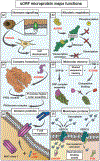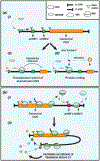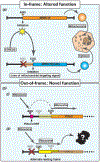The dark proteome: translation from noncanonical open reading frames
- PMID: 34844857
- PMCID: PMC8934435
- DOI: 10.1016/j.tcb.2021.10.010
The dark proteome: translation from noncanonical open reading frames
Abstract
Omics-based technologies have revolutionized our understanding of the coding potential of the genome. In particular, these studies revealed widespread unannotated open reading frames (ORFs) throughout genomes and that these regions have the potential to encode novel functional (micro-)proteins and/or hold regulatory roles. However, despite their genomic prevalence, relatively few of these noncanonical ORFs have been functionally characterized, likely in part due to their under-recognition by the broader scientific community. The few that have been investigated in detail have demonstrated their essentiality in critical and divergent biological processes. As such, here we aim to discuss recent advances in understanding the diversity of noncanonical ORFs and their roles, as well as detail biologically important examples within the context of the mammalian genome.
Keywords: CRISPR; microproteins; noncanonical ORFs; ribosome profiling; short ORFs; translation.
Copyright © 2021 Elsevier Ltd. All rights reserved.
Conflict of interest statement
Declaration on Interests∣
J.S.W. declares outside interest in 5 AM Venture, Amgen, Chroma Medicine, KSQ Therapeutics, Maze Therapeutics, Tenaya Therapeutics, Tessera Therapeutics, Third Rock Ventures, and Velia Therapeutics. J.C. consults for Velia Therapeutics.
Figures




Similar articles
-
Reconsidering proteomic diversity with functional investigation of small ORFs and alternative ORFs.Exp Cell Res. 2020 Aug 1;393(1):112057. doi: 10.1016/j.yexcr.2020.112057. Epub 2020 May 6. Exp Cell Res. 2020. PMID: 32387289 Review.
-
Widespread stable noncanonical peptides identified by integrated analyses of ribosome profiling and ORF features.Nat Commun. 2024 Mar 2;15(1):1932. doi: 10.1038/s41467-024-46240-9. Nat Commun. 2024. PMID: 38431639 Free PMC article.
-
De novo birth of functional microproteins in the human lineage.Cell Rep. 2022 Dec 20;41(12):111808. doi: 10.1016/j.celrep.2022.111808. Cell Rep. 2022. PMID: 36543139 Free PMC article.
-
What Can Ribo-Seq, Immunopeptidomics, and Proteomics Tell Us About the Noncanonical Proteome?Mol Cell Proteomics. 2023 Sep;22(9):100631. doi: 10.1016/j.mcpro.2023.100631. Epub 2023 Aug 11. Mol Cell Proteomics. 2023. PMID: 37572790 Free PMC article.
-
Short open reading frames (sORFs) and microproteins: an update on their identification and validation measures.J Biomed Sci. 2022 Mar 17;29(1):19. doi: 10.1186/s12929-022-00802-5. J Biomed Sci. 2022. PMID: 35300685 Free PMC article. Review.
Cited by
-
Exploring the Dark Matter of Human Proteome: The Emerging Role of Non-Canonical Open Reading Frame (ncORF) in Cancer Diagnosis, Biology, and Therapy.Cancers (Basel). 2024 Jul 26;16(15):2660. doi: 10.3390/cancers16152660. Cancers (Basel). 2024. PMID: 39123386 Free PMC article. Review.
-
Long noncoding RNAs as versatile molecular regulators of cellular stress response and homeostasis.Hum Genet. 2024 Jul;143(7):813-829. doi: 10.1007/s00439-023-02604-7. Epub 2023 Oct 2. Hum Genet. 2024. PMID: 37782337 Free PMC article. Review.
-
Microproteins: Overlooked regulators of physiology and disease.iScience. 2023 Apr 29;26(6):106781. doi: 10.1016/j.isci.2023.106781. eCollection 2023 Jun 16. iScience. 2023. PMID: 37213226 Free PMC article. Review.
-
Upstream open reading frames: new players in the landscape of cancer gene regulation.NAR Cancer. 2024 May 20;6(2):zcae023. doi: 10.1093/narcan/zcae023. eCollection 2024 Jun. NAR Cancer. 2024. PMID: 38774471 Free PMC article. Review.
-
Mass Spectrometry-Based Workflow for the Identification and Quantification of Alternative and Canonical Proteins in Pancreatic Cancer Cells.Cells. 2024 Nov 28;13(23):1966. doi: 10.3390/cells13231966. Cells. 2024. PMID: 39682715 Free PMC article.
References
Publication types
MeSH terms
Substances
Grants and funding
LinkOut - more resources
Full Text Sources
Other Literature Sources
Research Materials

